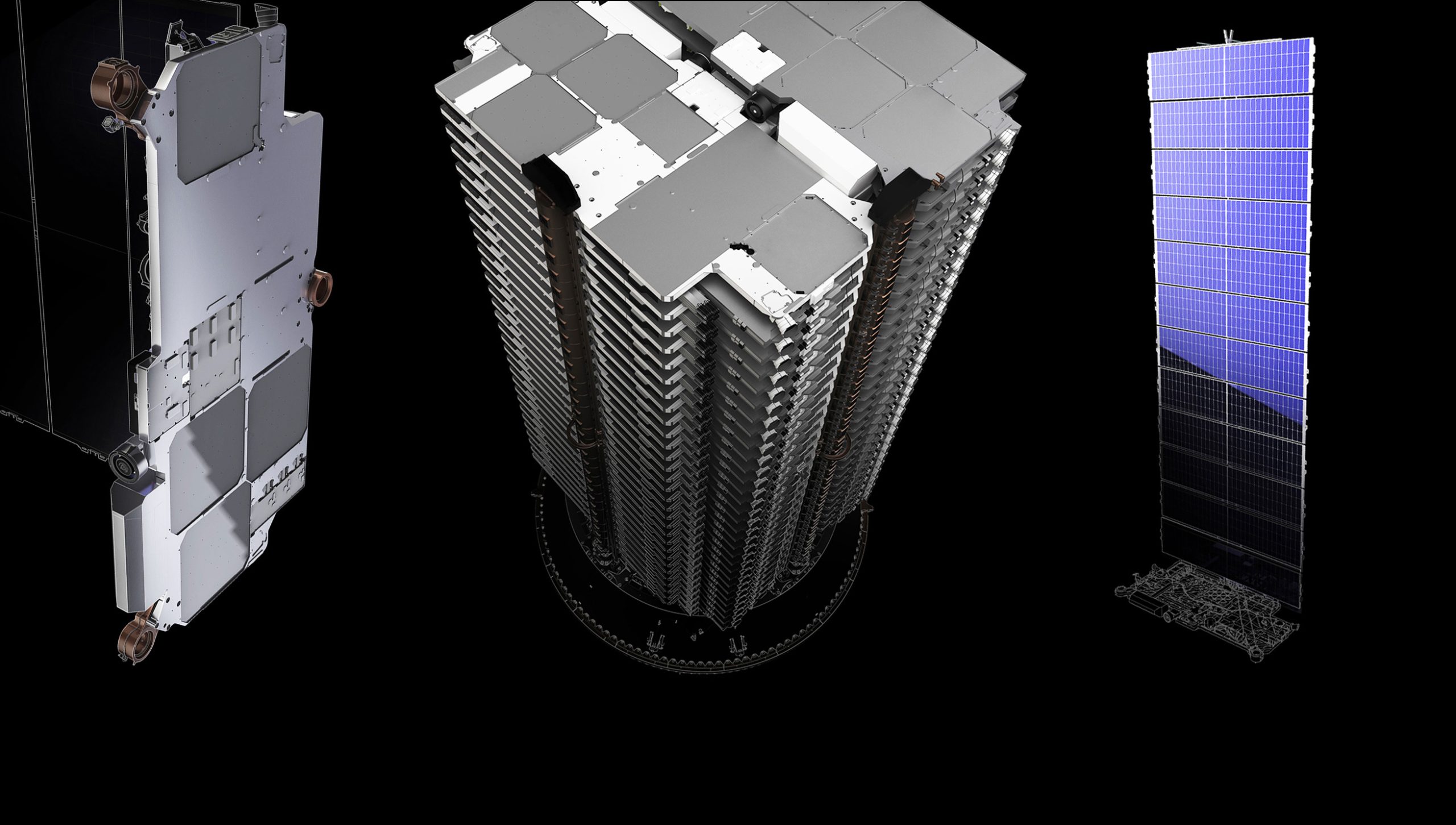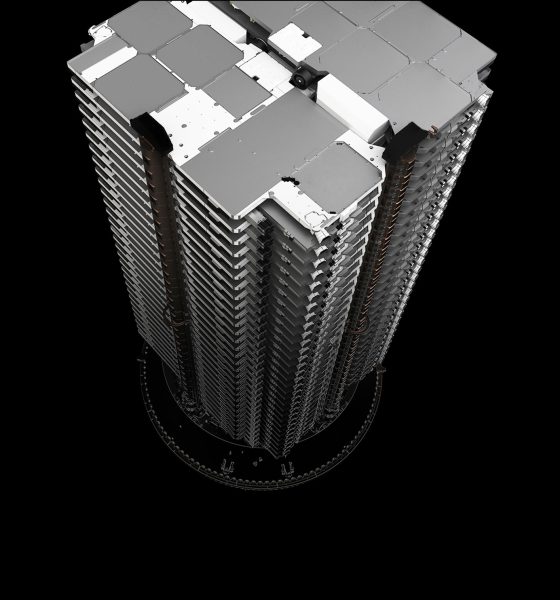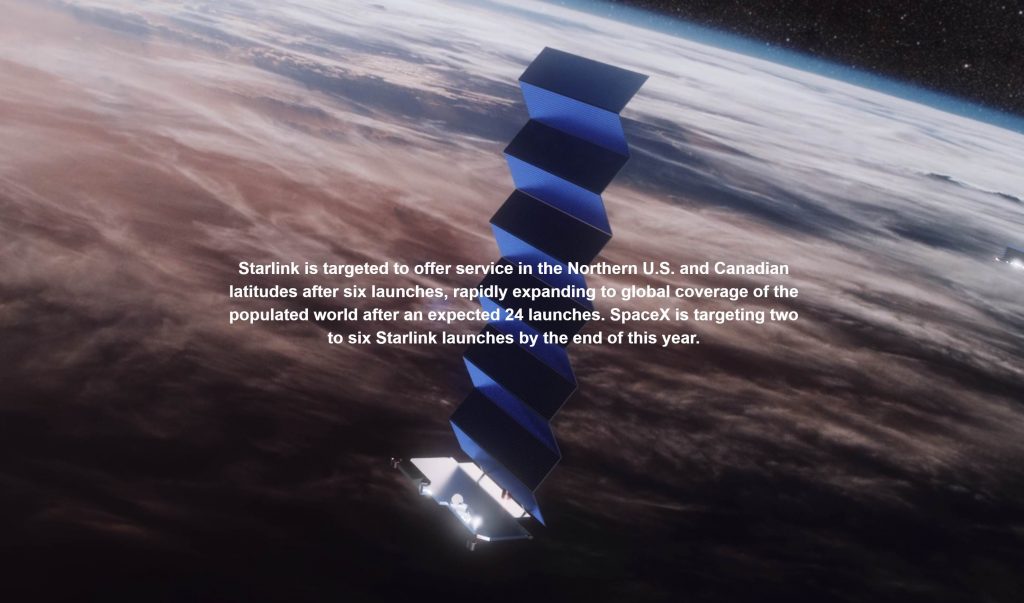

News
SpaceX wants to offer Starlink internet to consumers after just six launches
SpaceX has created a brand new website dedicated to its Starlink satellite constellation, a prelude to offering Internet service to consumers after as few as six launches.
Additionally, Starlink.com reiterated CEO Elon Musk’s estimate that SpaceX will conduct 2-6 dedicated Starlink launches – carrying at least 60 satellites each – in 2019 alone. In other words, a best-case satellite deployment scenario could mean that SpaceX will be able to start offering Starlink service to consumers “in the Northern U.S. and Canadian latitudes” as early as this year, while commercial offerings would thus be all but guaranteed in 2020. A step further, SpaceX believes it will be able to offer coverage of the entirety of the populated world after as few as 24 launches (~1500 Starlink satellites).

“Starlink is targeted to offer service in the Northern U.S. and Canadian latitudes after six launches, rapidly expanding to global coverage of the populated world after an expected 24 launches. SpaceX is targeting two to six Starlink launches by the end of this year.” — SpaceX, Starlink.com
This quiet announcement of SpaceX’s expected initial operational capability (IOC) confirms that the company’s plans to offer communications services to consumers are just as ambitious as its 60-satellite, 18.5 ton (~40,000 lb) Starlink launch debut. Assuming an average of 60 Starlink satellites per launch, SpaceX wants to begin serving customers in the US and Canada as soon as ~360 spacecraft are in orbit, a milestone that could occur as early as late 2019. Sometime in the first half of 2020 is arguably far more likely, but the fact alone that service could be offered in 2019 illustrates just how far SpaceX is ahead of its competitors, of which only OneWeb seems to pose an actual threat.
On February 27th, OneWeb launched its first six satellites – down from a planned ten, already ~20 satellites short of a ‘full’ launch – as a mix between its first orbital test and the first launch of operational spacecraft. OneWeb’s initial constellation will feature 648 satellites, potentially rising to 900 and eventually ~2000 in the years to come, pending commercial success and investor interest. The company currently has plans to begin a monthly launch campaign of ~20 Soyuz rockets no earlier than than August or September 2019, likely completing the first phase of its constellation sometime in 2021.
“OneWeb and its satellite manufacturing partner Airbus Defence and Space have crammed 10 gigabits per second of capacity into spacecraft the size of dishwashers. Tom Enders, Airbus Group’s outgoing CEO, said Feb. 14 that OneWeb satellites cost $1 million each to produce, and that the companies will be able to complete 350 to 400 satellites annually from their joint venture OneWeb Satellite’s $85 million Florida factory opening in April. The first batches of Florida-built satellites should be delivered to OneWeb toward the end of the third quarter, Airbus spokesman Guilhem Boltz said.”
SpaceNews, March 2019
Assuming SpaceX aims to launch one dedicated 60-satellite Starlink mission every 6-8 weeks, the company could easily have a constellation of more than 600 satellites in orbit by the end of 2020. Compared to OneWeb, each Starlink satellite weighs about 40% more (~150 kg vs. ~230 kg) but also offers almost double the usable throughput (~17-20 Gbps vs. OneWeb’s ~10 Gbps). In short, SpaceX should be able to offer the same capacity of coverage and service as soon – if not far sooner – than OneWeb, while constellation hopefuls like Telesat, LeoSat, and Amazon’s Project Kuiper are likely 2-5 years away from launching their first satellites, let alone offering service.

SpaceX’s foray into satellite design
Aside from revealing SpaceX’s tentative schedule for its Starlink service offerings, Starlink.com included excellent, surprisingly detailed renders of satellite hardware, ranging from Dragon-heritage star trackers to the world’s first flightworthy ion thrusters powered by krypton. These renders simply confirm what was already clear: SpaceX has gone against the grain of traditional satellite design at almost every turn, producing a bus (the general structure and form factor) that is unlike almost anything that came before it.



As a complete layperson to spacecraft design, it’s hard to describe SpaceX’s first internally designed satellite bus as anything less than elegant. Thanks to their uniquely flat form factor, the satellites can be packed into a Falcon 9 fairing with extreme efficiency, making SpaceX’s first dedicated Starlink launch the company’s heaviest payload ever at more than 18.5 tons (~40,000 lb). For comparison, OneWeb plans to launch approximately 30×150 kg satellites per Soyuz 2.1 launch with a traditional cylindrical adapter, itself weighing ~1000 kg.
For Starlink, the method the 60 satellites use to securely attach to each other remains a minor mystery, only hinted at by photos and renders that show three metal rings/connectors per satellite. However it works, it appears that SpaceX has found a way to launch and deploy dozens of fairly large spacecraft while wasting little to no mass on a dedicated dispenser. Altogether, it appears that SpaceX has already begun to surpass the technological capabilities of its competitors, while also taking large risks with highly innovative, largely unprecedented design choices. All of those characteristics will help as SpaceX pushes to deploy Starlink and begin serving customers as quickly as possible.
Check out Teslarati’s Marketplace! We offer Tesla accessories, including for the Tesla Cybertruck and Tesla Model 3.

News
Tesla hints at Starlink integration with recent patent
“By employing polymer blends, some examples enable RF transmission from all the modules to satellites and other communication devices both inside and outside the vehicle.”

Tesla hinted at a potential Starlink internet terminal integration within its vehicles in a recent patent, which describes a vehicle roof assembly with integrated radio frequency (RF) transparency.
The patent, which is Pub. No U.S. 2025/0368267 describes a new vehicle roof that is made of RF-transparent polymer materials, allowing and “facilitating clear communication with external devices and satellites.”
Tesla believes that a new vehicle roof design, comprised of different materials than the standard metallic or glass elements used in cars today, would allow the company to integrate modern vehicular technologies, “particularly those requiring radio frequency transmission and reception.
Tesla has recently filed a US patent application on integrating RF transparent materials into the roof structure.
“facilitating clear communication with external devices and satellites”
Tesla fleet is getting @Starlink connectivity integration soon. LFG @Tesla @elonmusk… pic.twitter.com/bLa8YtPLd1
— Chansoo Byeon (@Chansoo) December 9, 2025
Instead of glass or metallic materials, Tesla says vehicles may benefit from high-strength polymer blends, such as Polycarbonate, Acrylonitrile Butadiene Styrene, or Acrylonitrile Styrene Acrylate.
These materials still provide ideal strength metrics for crashworthiness, stiffness for noise, vibration, and harshness control, and are compliant with head impact regulations.
They would also enable better performance with modern technologies, like internet terminals, which need an uninterrupted signal to satellites for maximum reception. Tesla writes in the patent:
“By employing polymer blends, some examples enable RF transmission from all the modules to satellites and other communication devices both inside and outside the vehicle.”

One of the challenges Tesla seems to be aware of with this type of roof design is the fact that it will still have to enable safety and keep that at the forefront of the design. As you can see in the illustration above, Tesla plans to use four layers to increase safety and rigidity, while also combating noise and vibration.
It notes in the patent that disclosed examples still meet the safety requirements outlined in the Federal Motor Vehicle Safety Standards (FMVSS).
Starlink integrated directly into Tesla vehicles would be a considerable advantage for owners. It would come with a handful of distinct advantages.
Initially, the inclusion of Starlink would completely eliminate cellular dead zones, something that is an issue, especially in rural areas. Starlink would provide connectivity in these remote regions and would ensure uninterrupted service during road trips and off-grid adventures.
It could also be a critical addition for Robotaxi, as it is crucial to have solid and reliable connectivity for remote monitoring and fleet management.
Starlink’s growing constellation, thanks to SpaceX’s routine and frequent launch schedule, will provide secure, stable, and reliable internet connectivity for Tesla vehicles.
Although many owners have already mounted Starlink Mini dishes under their glass roofs for a similar experience, it may be integrated directly into Teslas in the coming years, either as an upgrade or a standard feature.
News
Tesla supplements Holiday Update by sneaking in new Full Self-Driving version
It seems Tesla was waiting for the Hardware 4 rollout, as it wanted to also deploy a new Full Self-Driving version to those owners, as it appeared in the release notes for the Holiday Update last night.

Tesla has surprised some owners by sneaking in a new Full Self-Driving version with the wide release of the Holiday Update, which started rolling out to Hardware 4 owners on Friday night.
Tesla has issued a controlled and very slow release pattern with the Holiday Update, which rolls out with Software Version 2025.44.25.5.
For the past two weeks, as it has rolled out to Hardware 3 and older Tesla owners, the company has kept its deployment of the new Software Version relatively controlled.
It seems Tesla was waiting for the Hardware 4 rollout, as it wanted to also deploy a new Full Self-Driving version to those owners, as it appeared in the release notes for the Holiday Update last night.
Tesla Full Self-Driving v14.2.1.25 made its first appearance last night to Hardware 4 owners who are members of the Early Access Program (EAP). It appears to be a slight refinement from FSD v14.2.1, which has been out for a couple of weeks.
Tesla v2025.44.25.5 Holiday update incoming
Also Full Self-Driving v14.2.1.25!!! pic.twitter.com/74D7S0UGXz
— TESLARATI (@Teslarati) December 13, 2025
Many owners welcome the new FSD version, us included, because we’ve been less than impressed with v14.2.1. We have experienced some minor regressions with v14.2.1, especially with Speed Limit recognition, Speed Profile tinkering, and parking performance.
As it stands, Full Self-Driving is still particularly impressive, but Tesla is evidently having an issue with some of the adjustments, as it is still refining some of the performance aspects of the suite. This is expected and normal with some updates, as not all of them are an improvement in all areas; we routinely see some things backtrack every once in a while.
This new FSD version is likely to take care of those things, but it also includes all of the awesome Holiday Update features, which include:
- Grok with Navigation Commands (Beta) – Grok will now add and edit destinations.
- Tesla Photobooth – Take pictures inside your car using the cabin-facing camera
- Dog Mode Live Activity – Check on your four-legged friend on your phone through periodic snapshots taken of the cabin
- Dashcam Viewer Update – Includes new metrics, like steering wheel angle, speed, and more
- Santa Mode – New graphics, trees, and a lock chime
- Light Show Update – Addition of Jingle Rush light show
- Custom Wraps and License Plates – Colorizer now allows you to customize your vehicle even further, with custom patterns, license plates, and tint
- Navigation Improvements – Easier layout and setup
- Supercharger Site Map – Starting at 18 pilot locations, a 3D view of the Supercharger you’re visiting will be available
- Automatic Carpool Lane Routing – Navigation will utilize carpool lanes if enabled
- Phone Left Behind Chime – Your car will now tell you if you left a phone inside
- Charge Limit Per Location – Set a charge limit for each location
- ISS Docking Simulator – New game
- Additional Improvements – Turn off wireless charging pad, Spotify improvements, Rainbow Rave Cave, Lock Sound TRON addition
Tesla also added two other things that were undocumented, like Charging Passport and information on USB drive storage to help with Dashcam.
Cybertruck
Tesla updates Cybertruck owners about key Powershare feature

Tesla is updating Cybertruck owners on its timeline of a massive feature that has yet to ship: Powershare with Powerwall.
Powershare is a bidirectional charging feature exclusive to Cybertruck, which allows the vehicle’s battery to act as a portable power source for homes, appliances, tools, other EVs, and more. It was announced in late 2023 as part of Tesla’s push into vehicle-to-everything energy sharing, and acting as a giant portable charger is the main advantage, as it can provide backup power during outages.
Cybertruck’s Powershare system supports both vehicle-to-load (V2L) and vehicle-to-home (V2H), making it flexible and well-rounded for a variety of applications.
However, even though the feature was promised with Cybertruck, it has yet to be shipped to vehicles. Tesla communicated with owners through email recently regarding Powershare with Powerwall, which essentially has the pickup act as an extended battery.
Powerwall discharge would be prioritized before tapping into the truck’s larger pack.
However, Tesla is still working on getting the feature out to owners, an email said:
“We’re writing to let you know that the Powershare with Powerwall feature is still in development and is now scheduled for release in mid-2026.
This new release date gives us additional time to design and test this feature, ensuring its ability to communicate and optimize energy sharing between your vehicle and many configurations and generations of Powerwall. We are also using this time to develop additional Powershare features that will help us continue to accelerate the world’s transition to sustainable energy.”
Owners have expressed some real disappointment in Tesla’s continuous delays in releasing the feature, as it was expected to be released by late 2024, but now has been pushed back several times to mid-2026, according to the email.
Foundation Series Cybertruck buyers paid extra, expecting the feature to be rolled out with their vehicle upon pickup.
Cybertruck’s Lead Engineer, Wes Morrill, even commented on the holdup:
As a Cybertruck owner who also has Powerwall, I empathize with the disappointed comments.
To their credit, the team has delivered powershare functionality to Cybertruck customers who otherwise have no backup with development of the powershare gateway. As well as those with solar…
— Wes (@wmorrill3) December 12, 2025
He said that “it turned out to be much harder than anticipated to make powershare work seamlessly with existing Powerwalls through existing wall connectors. Two grid-forming devices need to negotiate who will form and who will follow, depending on the state of charge of each, and they need to do this without a network and through multiple generations of hardware, and test and validate this process through rigorous certifications to ensure grid safety.”
It’s nice to see the transparency, but it is justified for some Cybertruck owners to feel like they’ve been bait-and-switched.








